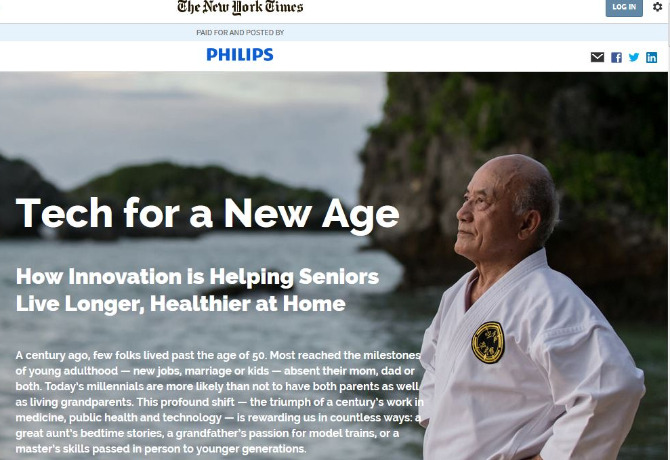Global brand teams need “real creativity” to devise stand-out marketing, and not just data and analytics skills, according to Philips marketer Eva Barrett.
Barrett, Philips’ global head of brand marketing communications, is set to speak at this Thursday’s (29 October) Newscred #ThinkContent Tour event in London.
She will outline Philips’ move to a content-driven marketing strategy, launched in late 2013 to promote its ‘Innovation That Matters To You’ brand positioning.
Known primarily as a consumer electronics brand, Philips has made a concerted effort to build awareness of its work in healthcare. It hosts a series of 50 films showing the impact of its innovations on a new digital platform, before distributing the content through media owners like Forbes, LinkedIn and the Washington Post. The brand has also partnered with The New York Times (NYT) to produce monthly brand ‘stories’ (see below).
More recently, it has embraced “even more engaging” content techniques, such as “living labs” – one in Uppsala, Sweden, tracked the impact on a community by lighting a public park during the dark winter days and nights.
So how did the brand get started on this path?
“’We’ve been in healthcare 100 years but we’re not known for the full suite of our solutions,” says Barrett, a former marketer at Adidas and Fosters. “My team’s role is to change that perception, and show the world that Philips is an innovative healthtech company.”
Barrett and her team reached out to Philips’ array of business units, across over 160 countries, in search of employees’ “authentic stories” showing how Philips is improving people’s lives. The result? “We were flooded,” she claims.
“We’re now in an age where people want engaging, emotional stories, and it doesn’t matter if it’s B2C or B2B,” she says.
“Our core audience is C-suite, key opinion leaders and influencers. Often, when you look at B2B communications, it’s often not very good. Yet healthcare is very emotional. For us it made sense to tell authentic, emotional, engaging stories. That is how we can get a real connection with people.”
More direct relationship
Philips has embraced a more direct relationship with media partners such as NYT, in an effort to ensure the content is as compelling and accurate as possible – which is changing the way it works with media agencies.
Each month, NYT branded content journalists spend time with the brand’s scientists and engineers, rather than relaying messages through agency contacts.
“In the past, you would create an integrated campaign [and then] brief your media agency. It was very much briefed on reach, frequency and impressions, which is no longer the case. We don’t want a bucket-load of impressions; we want engagement. That is what we discuss with our media agency,” says Barrett.
“From there, we work directly with our media partner in developing that content, as opposed to through the agency. With the NYT, every month we work directly with their team on producing articles, films and infographics. That’s a different model. We need our partners to understand our business. It is better if they understand what we do, so they can write better stories.”
While there is a need to create standout content, Barrett insists Philips would not abandon the use of traditional media to drive awareness and “eyeballs”. “It still enables us to reach our audience,” she adds.
However, there is a need for senior marketers to balance out the data and analytics capabilities with more editorial skills, she argues: “Before, from a marketing perspective, you would have a team comprising campaign managers, digital managers, social media managers. Now, you also need editorial skills, and there is a lot more legal and regulatory knowledge that needs to go behind it.
“When I’m hiring, I’m looking for real creativity. You can have analytical marketing, but just data and analytics isn’t going to make a difference nowadays. What makes a difference is having really creative people on your team.”








